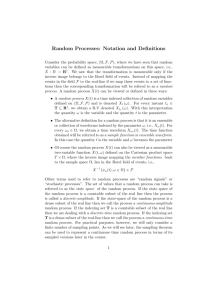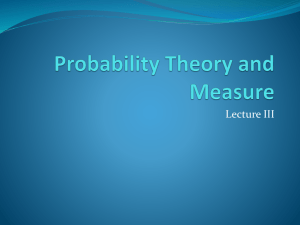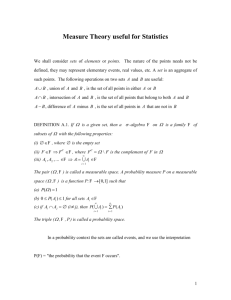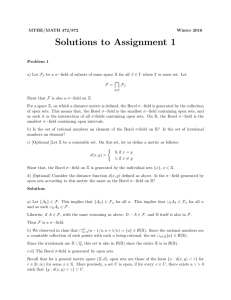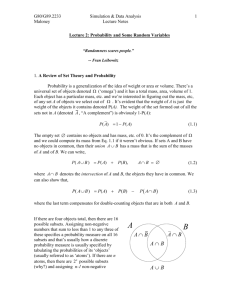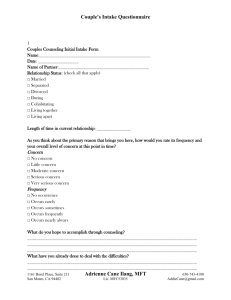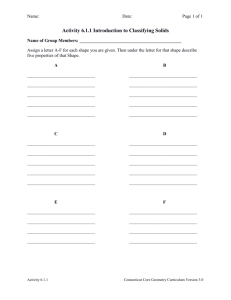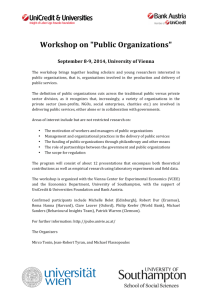Borel reducibility and classifying factors R. Sasyk (Bs. As.) ornquist (Vienna)
advertisement
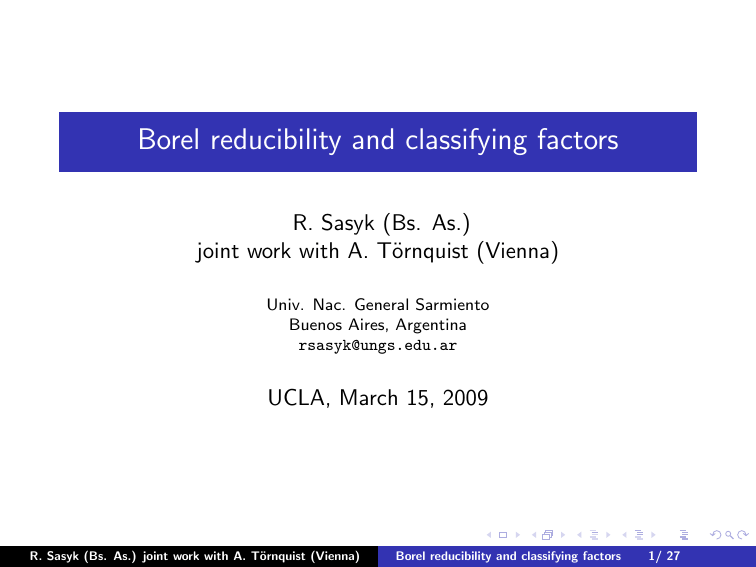
Borel reducibility and classifying factors
R. Sasyk (Bs. As.)
joint work with A. Törnquist (Vienna)
Univ. Nac. General Sarmiento
Buenos Aires, Argentina
rsasyk@ungs.edu.ar
UCLA, March 15, 2009
R. Sasyk (Bs. As.) joint work with A. Törnquist (Vienna)
Borel reducibility and classifying factors
1/ 27
Borel reducibility
Definition. Let E and F be equivalence relations on standard Borel
spaces X and Y respectively.
R. Sasyk (Bs. As.) joint work with A. Törnquist (Vienna)
Borel reducibility and classifying factors
2/ 27
Borel reducibility
Definition. Let E and F be equivalence relations on standard Borel
spaces X and Y respectively.
E is Borel reducible to F , written E ≤B F , if there is a Borel
f : X → Y such that
xEy ⇐⇒ f (x)Ff (y ).
R. Sasyk (Bs. As.) joint work with A. Törnquist (Vienna)
Borel reducibility and classifying factors
2/ 27
Borel reducibility
Definition. Let E and F be equivalence relations on standard Borel
spaces X and Y respectively.
E is Borel reducible to F , written E ≤B F , if there is a Borel
f : X → Y such that
xEy ⇐⇒ f (x)Ff (y ).
This means that the points of X can be classified up to
E -equivalence by a Borel assignment of invariants that are
F -equivalence classes.
R. Sasyk (Bs. As.) joint work with A. Törnquist (Vienna)
Borel reducibility and classifying factors
2/ 27
Borel reducibility
Definition. Let E and F be equivalence relations on standard Borel
spaces X and Y respectively.
E is Borel reducible to F , written E ≤B F , if there is a Borel
f : X → Y such that
xEy ⇐⇒ f (x)Ff (y ).
This means that the points of X can be classified up to
E -equivalence by a Borel assignment of invariants that are
F -equivalence classes.
f is required to be Borel to make sure that the invariant f (x) has a
reasonable computation from x.
R. Sasyk (Bs. As.) joint work with A. Törnquist (Vienna)
Borel reducibility and classifying factors
2/ 27
Borel reducibility
Definition. Let E and F be equivalence relations on standard Borel
spaces X and Y respectively.
E is Borel reducible to F , written E ≤B F , if there is a Borel
f : X → Y such that
xEy ⇐⇒ f (x)Ff (y ).
This means that the points of X can be classified up to
E -equivalence by a Borel assignment of invariants that are
F -equivalence classes.
f is required to be Borel to make sure that the invariant f (x) has a
reasonable computation from x.
Without a requirement on f , the definition would only amount to
studying the cardinality of X /E vs. Y /F .
R. Sasyk (Bs. As.) joint work with A. Törnquist (Vienna)
Borel reducibility and classifying factors
2/ 27
Smooth equivalence relations
Let X be a standard Borel space and E an equiv. rel. on X .
R. Sasyk (Bs. As.) joint work with A. Törnquist (Vienna)
Borel reducibility and classifying factors
3/ 27
Smooth equivalence relations
Let X be a standard Borel space and E an equiv. rel. on X .
Definition. E is smooth or countably separated or concretely
classifiable if ∃ {An }n∈N Borel subsets of X such that
xEy ⇐⇒ (∀n ∈ N)x ∈ An ⇐⇒ y ∈ An
.
R. Sasyk (Bs. As.) joint work with A. Törnquist (Vienna)
Borel reducibility and classifying factors
3/ 27
Smooth equivalence relations
Let X be a standard Borel space and E an equiv. rel. on X .
Definition. E is smooth or countably separated or concretely
classifiable if ∃ {An }n∈N Borel subsets of X such that
xEy ⇐⇒ (∀n ∈ N)x ∈ An ⇐⇒ y ∈ An
.
Same as E ≤B =R , where =R denotes the equality relation in R.
R. Sasyk (Bs. As.) joint work with A. Törnquist (Vienna)
Borel reducibility and classifying factors
3/ 27
Smooth equivalence relations
Let X be a standard Borel space and E an equiv. rel. on X .
Definition. E is smooth or countably separated or concretely
classifiable if ∃ {An }n∈N Borel subsets of X such that
xEy ⇐⇒ (∀n ∈ N)x ∈ An ⇐⇒ y ∈ An
.
Same as E ≤B =R , where =R denotes the equality relation in R.
Example 1: X the set of n × n matrices , E = similarity.
f (A) =Jordan form of A.
R. Sasyk (Bs. As.) joint work with A. Törnquist (Vienna)
Borel reducibility and classifying factors
3/ 27
Smooth equivalence relations
Let X be a standard Borel space and E an equiv. rel. on X .
Definition. E is smooth or countably separated or concretely
classifiable if ∃ {An }n∈N Borel subsets of X such that
xEy ⇐⇒ (∀n ∈ N)x ∈ An ⇐⇒ y ∈ An
.
Same as E ≤B =R , where =R denotes the equality relation in R.
Example 1: X the set of n × n matrices , E = similarity.
f (A) =Jordan form of A.
Example 2 (Ornstein-Bowen): X Classical Bernoulli shifts, E
conjugacy. f (T ) = the entropy of T .
R. Sasyk (Bs. As.) joint work with A. Törnquist (Vienna)
Borel reducibility and classifying factors
3/ 27
The equivalence relation E0
The simplest example of a non-smooth equivalence relation is E0 ,
defined on 2N , by
xEy ⇐⇒ (∃N)(∀n ≥ N)x(n) = y (n).
R. Sasyk (Bs. As.) joint work with A. Törnquist (Vienna)
Borel reducibility and classifying factors
4/ 27
The equivalence relation E0
The simplest example of a non-smooth equivalence relation is E0 ,
defined on 2N , by
xEy ⇐⇒ (∃N)(∀n ≥ N)x(n) = y (n).
Remark: If E0 ≤B E then E has uncountable many equivalence
classes.
R. Sasyk (Bs. As.) joint work with A. Törnquist (Vienna)
Borel reducibility and classifying factors
4/ 27
The equivalence relation E0
The simplest example of a non-smooth equivalence relation is E0 ,
defined on 2N , by
xEy ⇐⇒ (∃N)(∀n ≥ N)x(n) = y (n).
Remark: If E0 ≤B E then E has uncountable many equivalence
classes.
Theorem (Baer)
The isomorphism relation for countable rank 1 torsion free abelian
groups is Borel bireducible to E0 .
R. Sasyk (Bs. As.) joint work with A. Törnquist (Vienna)
Borel reducibility and classifying factors
4/ 27
The Effros Borel space
Let H be a separable Hilbert space and vN(H) the set of von
Neumann algebras on H.
R. Sasyk (Bs. As.) joint work with A. Törnquist (Vienna)
Borel reducibility and classifying factors
5/ 27
The Effros Borel space
Let H be a separable Hilbert space and vN(H) the set of von
Neumann algebras on H. vN(H) can be given a standard Borel
structure called the Effros Borel structure.
R. Sasyk (Bs. As.) joint work with A. Törnquist (Vienna)
Borel reducibility and classifying factors
5/ 27
The Effros Borel space
Let H be a separable Hilbert space and vN(H) the set of von
Neumann algebras on H. vN(H) can be given a standard Borel
structure called the Effros Borel structure.
This Borel structure is generated by the sets
{M ∈ vN(H) : M ∩ U 6= ∅}
where U is a weakly open subset of B(H)
R. Sasyk (Bs. As.) joint work with A. Törnquist (Vienna)
Borel reducibility and classifying factors
5/ 27
The Effros Borel space
Let H be a separable Hilbert space and vN(H) the set of von
Neumann algebras on H. vN(H) can be given a standard Borel
structure called the Effros Borel structure.
This Borel structure is generated by the sets
{M ∈ vN(H) : M ∩ U 6= ∅}
where U is a weakly open subset of B(H)
Theorem (Effros ’64): Sets of factors of types I, II1 , II∞ , IIIλ ,
0 ≤ λ ≤ 1 are Borel sets.
R. Sasyk (Bs. As.) joint work with A. Törnquist (Vienna)
Borel reducibility and classifying factors
5/ 27
The Effros Borel space
Let H be a separable Hilbert space and vN(H) the set of von
Neumann algebras on H. vN(H) can be given a standard Borel
structure called the Effros Borel structure.
This Borel structure is generated by the sets
{M ∈ vN(H) : M ∩ U 6= ∅}
where U is a weakly open subset of B(H)
Theorem (Effros ’64): Sets of factors of types I, II1 , II∞ , IIIλ ,
0 ≤ λ ≤ 1 are Borel sets.
Hope: The equivalence relation E = isomorphism of factors is not
smooth.
R. Sasyk (Bs. As.) joint work with A. Törnquist (Vienna)
Borel reducibility and classifying factors
5/ 27
The Effros Borel space
Let H be a separable Hilbert space and vN(H) the set of von
Neumann algebras on H. vN(H) can be given a standard Borel
structure called the Effros Borel structure.
This Borel structure is generated by the sets
{M ∈ vN(H) : M ∩ U 6= ∅}
where U is a weakly open subset of B(H)
Theorem (Effros ’64): Sets of factors of types I, II1 , II∞ , IIIλ ,
0 ≤ λ ≤ 1 are Borel sets.
Hope: The equivalence relation E = isomorphism of factors is not
smooth.This would show there are uncountably many factors.
R. Sasyk (Bs. As.) joint work with A. Törnquist (Vienna)
Borel reducibility and classifying factors
5/ 27
The Effros Borel space
Let H be a separable Hilbert space and vN(H) the set of von
Neumann algebras on H. vN(H) can be given a standard Borel
structure called the Effros Borel structure.
This Borel structure is generated by the sets
{M ∈ vN(H) : M ∩ U 6= ∅}
where U is a weakly open subset of B(H)
Theorem (Effros ’64): Sets of factors of types I, II1 , II∞ , IIIλ ,
0 ≤ λ ≤ 1 are Borel sets.
Hope: The equivalence relation E = isomorphism of factors is not
smooth.This would show there are uncountably many factors.
Theorem (Woods ’71): E0 ≤B ITPFI' .
R. Sasyk (Bs. As.) joint work with A. Törnquist (Vienna)
Borel reducibility and classifying factors
5/ 27
Borel-reducibility hierarchy
Theorem (Effros-Glimm dichotomy, (Harrington-K.-L. 90))
E is a Borel equivalence relation. Either E is smooth or E0 ≤ E .
R. Sasyk (Bs. As.) joint work with A. Törnquist (Vienna)
Borel reducibility and classifying factors
6/ 27
Borel-reducibility hierarchy
Theorem (Effros-Glimm dichotomy, (Harrington-K.-L. 90))
E is a Borel equivalence relation. Either E is smooth or E0 ≤ E .
Facts:
1. In RN ,
xE1 y ⇐⇒ (∃N)(∀n > N) x(n) = y (n).
R. Sasyk (Bs. As.) joint work with A. Törnquist (Vienna)
Borel reducibility and classifying factors
6/ 27
Borel-reducibility hierarchy
Theorem (Effros-Glimm dichotomy, (Harrington-K.-L. 90))
E is a Borel equivalence relation. Either E is smooth or E0 ≤ E .
Facts:
1. In RN ,
xE1 y ⇐⇒ (∃N)(∀n > N) x(n) = y (n).
and
R. Sasyk (Bs. As.) joint work with A. Törnquist (Vienna)
Borel reducibility and classifying factors
6/ 27
Borel-reducibility hierarchy
Theorem (Effros-Glimm dichotomy, (Harrington-K.-L. 90))
E is a Borel equivalence relation. Either E is smooth or E0 ≤ E .
Facts:
1. In RN ,
xE1 y ⇐⇒ (∃N)(∀n > N) x(n) = y (n).
and
xE2 y ⇐⇒ lim (x(n) − y (n)) = 0
n→∞
are incomparable. (Kechris-Louveau)
R. Sasyk (Bs. As.) joint work with A. Törnquist (Vienna)
Borel reducibility and classifying factors
6/ 27
Borel-reducibility hierarchy
Theorem (Effros-Glimm dichotomy, (Harrington-K.-L. 90))
E is a Borel equivalence relation. Either E is smooth or E0 ≤ E .
Facts:
1. In RN ,
xE1 y ⇐⇒ (∃N)(∀n > N) x(n) = y (n).
and
xE2 y ⇐⇒ lim (x(n) − y (n)) = 0
n→∞
are incomparable. (Kechris-Louveau)
2. There exists a universal countable equivalence relation E∞
(i. e. E ≤B E∞ , E has countable orbits)
R. Sasyk (Bs. As.) joint work with A. Törnquist (Vienna)
Borel reducibility and classifying factors
6/ 27
Borel-reducibility hierarchy
Theorem (Effros-Glimm dichotomy, (Harrington-K.-L. 90))
E is a Borel equivalence relation. Either E is smooth or E0 ≤ E .
Facts:
1. In RN ,
xE1 y ⇐⇒ (∃N)(∀n > N) x(n) = y (n).
and
xE2 y ⇐⇒ lim (x(n) − y (n)) = 0
n→∞
are incomparable. (Kechris-Louveau)
2. There exists a universal countable equivalence relation E∞
(i. e. E ≤B E∞ , E has countable orbits)
3. E0 <B E <B E∞ (Jackson, K, L)
R. Sasyk (Bs. As.) joint work with A. Törnquist (Vienna)
Borel reducibility and classifying factors
6/ 27
Classification by countable structures
Definition. Let E be an equivalence relation on a Polish space X .
E is classifiable by countable structures if
E ≤B ESY∞
Where S∞ is the infinite symmetric group and ESY∞ denotes a Borel
equivalence relation induced by a continuous S∞ -action on Y .
R. Sasyk (Bs. As.) joint work with A. Törnquist (Vienna)
Borel reducibility and classifying factors
7/ 27
Classification by countable structures
Definition. Let E be an equivalence relation on a Polish space X .
E is classifiable by countable structures if
E ≤B ESY∞
Where S∞ is the infinite symmetric group and ESY∞ denotes a Borel
equivalence relation induced by a continuous S∞ -action on Y .
More standard definition (For logicians):
R. Sasyk (Bs. As.) joint work with A. Törnquist (Vienna)
Borel reducibility and classifying factors
7/ 27
Classification by countable structures
Definition. Let E be an equivalence relation on a Polish space X .
E is classifiable by countable structures if
E ≤B ESY∞
Where S∞ is the infinite symmetric group and ESY∞ denotes a Borel
equivalence relation induced by a continuous S∞ -action on Y .
More standard definition (For logicians):
Let L be a countable language. Mod(L) denotes the natural Polish
space of countable models of L with underlying set N. 'Mod(L)
denotes the isomorphism relation in Mod(L).
R. Sasyk (Bs. As.) joint work with A. Törnquist (Vienna)
Borel reducibility and classifying factors
7/ 27
Classification by countable structures
Definition. Let E be an equivalence relation on a Polish space X .
E is classifiable by countable structures if
E ≤B ESY∞
Where S∞ is the infinite symmetric group and ESY∞ denotes a Borel
equivalence relation induced by a continuous S∞ -action on Y .
More standard definition (For logicians):
Let L be a countable language. Mod(L) denotes the natural Polish
space of countable models of L with underlying set N. 'Mod(L)
denotes the isomorphism relation in Mod(L).
Definition. E is classifiable by countable structures if there is a
countable language L such that E ≤B 'Mod(L) .
R. Sasyk (Bs. As.) joint work with A. Törnquist (Vienna)
Borel reducibility and classifying factors
7/ 27
Classification by countable structures II
Example: Graphs as a countable structure.
R. Sasyk (Bs. As.) joint work with A. Törnquist (Vienna)
Borel reducibility and classifying factors
8/ 27
Classification by countable structures II
Example: Graphs as a countable structure.
GRAPHS = {f : N × N → {0, 1}f (x, x) = 0; f (x, y ) = f (y , x))}
R. Sasyk (Bs. As.) joint work with A. Törnquist (Vienna)
Borel reducibility and classifying factors
8/ 27
Classification by countable structures II
Example: Graphs as a countable structure.
GRAPHS = {f : N × N → {0, 1}f (x, x) = 0; f (x, y ) = f (y , x))}
f1 ∼ f2 ⇐⇒ ∃φ : N → N bijection s.t. f1 (x, y ) = f2 (φ(x), φ(y )).
R. Sasyk (Bs. As.) joint work with A. Törnquist (Vienna)
Borel reducibility and classifying factors
8/ 27
Classification by countable structures II
Example: Graphs as a countable structure.
GRAPHS = {f : N × N → {0, 1}f (x, x) = 0; f (x, y ) = f (y , x))}
f1 ∼ f2 ⇐⇒ ∃φ : N → N bijection s.t. f1 (x, y ) = f2 (φ(x), φ(y )).
S∞ acts on GRAPHS as Θ ∈ S∞ , Θf (x, y ) = f (Θ−1 (x), Θ−1 (y ))
R. Sasyk (Bs. As.) joint work with A. Törnquist (Vienna)
Borel reducibility and classifying factors
8/ 27
Classification by countable structures II
Example: Graphs as a countable structure.
GRAPHS = {f : N × N → {0, 1}f (x, x) = 0; f (x, y ) = f (y , x))}
f1 ∼ f2 ⇐⇒ ∃φ : N → N bijection s.t. f1 (x, y ) = f2 (φ(x), φ(y )).
S∞ acts on GRAPHS as Θ ∈ S∞ , Θf (x, y ) = f (Θ−1 (x), Θ−1 (y ))
The equivalence relations that are classifiable by countable
structures include all equivalence relations that can be classified
(reasonably) using countable groups, graphs, fields, etc., as
complete invariants.
R. Sasyk (Bs. As.) joint work with A. Törnquist (Vienna)
Borel reducibility and classifying factors
8/ 27
Classification by countable structures II
Example: Graphs as a countable structure.
GRAPHS = {f : N × N → {0, 1}f (x, x) = 0; f (x, y ) = f (y , x))}
f1 ∼ f2 ⇐⇒ ∃φ : N → N bijection s.t. f1 (x, y ) = f2 (φ(x), φ(y )).
S∞ acts on GRAPHS as Θ ∈ S∞ , Θf (x, y ) = f (Θ−1 (x), Θ−1 (y ))
The equivalence relations that are classifiable by countable
structures include all equivalence relations that can be classified
(reasonably) using countable groups, graphs, fields, etc., as
complete invariants.
Example I: E∞ ≤B ESY∞
R. Sasyk (Bs. As.) joint work with A. Törnquist (Vienna)
Borel reducibility and classifying factors
8/ 27
Classification by countable structures II
Example: Graphs as a countable structure.
GRAPHS = {f : N × N → {0, 1}f (x, x) = 0; f (x, y ) = f (y , x))}
f1 ∼ f2 ⇐⇒ ∃φ : N → N bijection s.t. f1 (x, y ) = f2 (φ(x), φ(y )).
S∞ acts on GRAPHS as Θ ∈ S∞ , Θf (x, y ) = f (Θ−1 (x), Θ−1 (y ))
The equivalence relations that are classifiable by countable
structures include all equivalence relations that can be classified
(reasonably) using countable groups, graphs, fields, etc., as
complete invariants.
Example I: E∞ ≤B ESY∞
Example II: (Halmos-vN) E = conjugacy of ergodic m.p.
transformations with discrete spectrum. σP (T ) is a complete
Y
invariant. E ≤B ES∞
R. Sasyk (Bs. As.) joint work with A. Törnquist (Vienna)
Borel reducibility and classifying factors
8/ 27
Classification by countable structures III
TURBULENCE (Hjorth 0 97 ∼0 00)
R. Sasyk (Bs. As.) joint work with A. Törnquist (Vienna)
Borel reducibility and classifying factors
9/ 27
Classification by countable structures III
TURBULENCE (Hjorth 0 97 ∼0 00)
A theory to show that an equivalence relation E is NOTclassifiable
by countable structures.
R. Sasyk (Bs. As.) joint work with A. Törnquist (Vienna)
Borel reducibility and classifying factors
9/ 27
Classification by countable structures III
TURBULENCE (Hjorth 0 97 ∼0 00)
A theory to show that an equivalence relation E is NOTclassifiable
by countable structures.
Example III: (Hjorth ’02?,Foreman-Weiss, ’04) Conjugacy of
MPET on ([0, 1], µ) is not classifiable by countable structures.
R. Sasyk (Bs. As.) joint work with A. Törnquist (Vienna)
Borel reducibility and classifying factors
9/ 27
Classification by countable structures III
TURBULENCE (Hjorth 0 97 ∼0 00)
A theory to show that an equivalence relation E is NOTclassifiable
by countable structures.
Example III: (Hjorth ’02?,Foreman-Weiss, ’04) Conjugacy of
MPET on ([0, 1], µ) is not classifiable by countable structures.
Example IV: (Kechris,Törnquist, 0 04 ∼ 0 06) OE of free, ergodic,
measure preserving Fn actions is not classifiable by countable
structures.
R. Sasyk (Bs. As.) joint work with A. Törnquist (Vienna)
Borel reducibility and classifying factors
9/ 27
Classification by countable structures III
TURBULENCE (Hjorth 0 97 ∼0 00)
A theory to show that an equivalence relation E is NOTclassifiable
by countable structures.
Example III: (Hjorth ’02?,Foreman-Weiss, ’04) Conjugacy of
MPET on ([0, 1], µ) is not classifiable by countable structures.
Example IV: (Kechris,Törnquist, 0 04 ∼ 0 06) OE of free, ergodic,
measure preserving Fn actions is not classifiable by countable
structures.
Example V: (Epstein-Ioana-Kechris-Tsankov, ’08) OE of G actions
for G non amenable is not classifiable by countable structures.
R. Sasyk (Bs. As.) joint work with A. Törnquist (Vienna)
Borel reducibility and classifying factors
9/ 27
Results: Theorem 1
Theorem (S.-Törnquist, ’08)
The isomorphism relation for separable von Neumann factors of
type II1 , II∞ and IIIλ , λ ∈ [0, 1], are not classifiable by countable
structures.
R. Sasyk (Bs. As.) joint work with A. Törnquist (Vienna)
Borel reducibility and classifying factors
10/ 27
Results: Theorem 1
Theorem (S.-Törnquist, ’08)
The isomorphism relation for separable von Neumann factors of
type II1 , II∞ and IIIλ , λ ∈ [0, 1], are not classifiable by countable
structures.
Corollary
The classification problem of II1 factors is not smooth.
R. Sasyk (Bs. As.) joint work with A. Törnquist (Vienna)
Borel reducibility and classifying factors
10/ 27
Results: Theorem 2
A factor M ∈ vN(H) is injective (or amenable or hyperfinite) if it
contains an increasing sequence of finite dimensional von Neumann
algebras, with dense union in M. For each of the types II1 , II∞ and
IIIλ , λ ∈ (0, 1], there is a unique injective factor of that type.
However, for type III0 we have:
R. Sasyk (Bs. As.) joint work with A. Törnquist (Vienna)
Borel reducibility and classifying factors
11/ 27
Results: Theorem 2
A factor M ∈ vN(H) is injective (or amenable or hyperfinite) if it
contains an increasing sequence of finite dimensional von Neumann
algebras, with dense union in M. For each of the types II1 , II∞ and
IIIλ , λ ∈ (0, 1], there is a unique injective factor of that type.
However, for type III0 we have:
Theorem (S.-Törnquist, ’08)
The isomorphism relation for injective factors of type III0 is not
classifiable by countable structures.
R. Sasyk (Bs. As.) joint work with A. Törnquist (Vienna)
Borel reducibility and classifying factors
11/ 27
Results: Theorem 2
A factor M ∈ vN(H) is injective (or amenable or hyperfinite) if it
contains an increasing sequence of finite dimensional von Neumann
algebras, with dense union in M. For each of the types II1 , II∞ and
IIIλ , λ ∈ (0, 1], there is a unique injective factor of that type.
However, for type III0 we have:
Theorem (S.-Törnquist, ’08)
The isomorphism relation for injective factors of type III0 is not
classifiable by countable structures.
(Compare with Woods’ Theorem: E0 ≤B ITPFI2' .)
R. Sasyk (Bs. As.) joint work with A. Törnquist (Vienna)
Borel reducibility and classifying factors
11/ 27
Results: Theorem 3
Denote by FII1 (H) the (standard) space of II1 factors on H, and by
'FII1 (H) the isomorphism relation for factors of type II1 on H.
R. Sasyk (Bs. As.) joint work with A. Törnquist (Vienna)
Borel reducibility and classifying factors
12/ 27
Results: Theorem 3
Denote by FII1 (H) the (standard) space of II1 factors on H, and by
'FII1 (H) the isomorphism relation for factors of type II1 on H.
Theorem (S.-Törnquist, ’08)
If L is a countable language then 'Mod(L) <B 'FII1 (H) .
R. Sasyk (Bs. As.) joint work with A. Törnquist (Vienna)
Borel reducibility and classifying factors
12/ 27
Results: Theorem 3
Denote by FII1 (H) the (standard) space of II1 factors on H, and by
'FII1 (H) the isomorphism relation for factors of type II1 on H.
Theorem (S.-Törnquist, ’08)
If L is a countable language then 'Mod(L) <B 'FII1 (H) .
As an immediate corollary, we have:
Corollary
The isomorphism relation for factors of type II1 is complete
analytic as a subset of FII1 (H) × FII1 (H). In particular it is not a
Borel subset.
R. Sasyk (Bs. As.) joint work with A. Törnquist (Vienna)
Borel reducibility and classifying factors
12/ 27
Outline of the proof of Theorem 1
The ingredients of the proof are:
R. Sasyk (Bs. As.) joint work with A. Törnquist (Vienna)
Borel reducibility and classifying factors
13/ 27
Outline of the proof of Theorem 1
The ingredients of the proof are:
I
Construct a suitably large family of measure preserving
ergodic actions of F3 , the free group on 3 generators,
R. Sasyk (Bs. As.) joint work with A. Törnquist (Vienna)
Borel reducibility and classifying factors
13/ 27
Outline of the proof of Theorem 1
The ingredients of the proof are:
I
Construct a suitably large family of measure preserving
ergodic actions of F3 , the free group on 3 generators,
I
Use these actions to construct a corresponding family of II1
factors, using the group-measure space construction,
R. Sasyk (Bs. As.) joint work with A. Törnquist (Vienna)
Borel reducibility and classifying factors
13/ 27
Outline of the proof of Theorem 1
The ingredients of the proof are:
I
Construct a suitably large family of measure preserving
ergodic actions of F3 , the free group on 3 generators,
I
Use these actions to construct a corresponding family of II1
factors, using the group-measure space construction,
I
Apply Popa’s deformation-rigidity techniques (HT factors) to
argue that the properties of the F3 -actions carry over to
properties of the corresponding factors,
R. Sasyk (Bs. As.) joint work with A. Törnquist (Vienna)
Borel reducibility and classifying factors
13/ 27
Outline of the proof of Theorem 1
The ingredients of the proof are:
I
Construct a suitably large family of measure preserving
ergodic actions of F3 , the free group on 3 generators,
I
Use these actions to construct a corresponding family of II1
factors, using the group-measure space construction,
I
Apply Popa’s deformation-rigidity techniques (HT factors) to
argue that the properties of the F3 -actions carry over to
properties of the corresponding factors,
I
Argue that the family of F3 -actions is too big to be classified
by countable structures.
R. Sasyk (Bs. As.) joint work with A. Törnquist (Vienna)
Borel reducibility and classifying factors
13/ 27
A class of F3 -actions
The F2 action σ obtained by restricting the SL2 (Z) action on T2 is
free, ergodic, and L∞ (T2 ) ⊂ L∞ (T2 ) oσ F2 has the relative
property (T).
R. Sasyk (Bs. As.) joint work with A. Törnquist (Vienna)
Borel reducibility and classifying factors
14/ 27
A class of F3 -actions
The F2 action σ obtained by restricting the SL2 (Z) action on T2 is
free, ergodic, and L∞ (T2 ) ⊂ L∞ (T2 ) oσ F2 has the relative
property (T). Let Ta and Tb be the transformations corresponding
to the generators a, b of F2 .
R. Sasyk (Bs. As.) joint work with A. Törnquist (Vienna)
Borel reducibility and classifying factors
14/ 27
A class of F3 -actions
The F2 action σ obtained by restricting the SL2 (Z) action on T2 is
free, ergodic, and L∞ (T2 ) ⊂ L∞ (T2 ) oσ F2 has the relative
property (T). Let Ta and Tb be the transformations corresponding
to the generators a, b of F2 .Let
Ext(σ) = {S ∈ Aut(T2 ) : S, Ta , Tb generate a free F3 -action}.
Then this set is a dense Gδ .
R. Sasyk (Bs. As.) joint work with A. Törnquist (Vienna)
Borel reducibility and classifying factors
14/ 27
A class of F3 -actions
The F2 action σ obtained by restricting the SL2 (Z) action on T2 is
free, ergodic, and L∞ (T2 ) ⊂ L∞ (T2 ) oσ F2 has the relative
property (T). Let Ta and Tb be the transformations corresponding
to the generators a, b of F2 .Let
Ext(σ) = {S ∈ Aut(T2 ) : S, Ta , Tb generate a free F3 -action}.
Then this set is a dense Gδ . For each S ∈ Ext(σ), let σS be the
corresponding a.e. free ergodic F3 -action. Define in Ext(σ) the
equivalence relation S ∼oe S 0 if and only if σS is orbit equivalent
to σS‘ .
R. Sasyk (Bs. As.) joint work with A. Törnquist (Vienna)
Borel reducibility and classifying factors
14/ 27
A class of F3 -actions
The F2 action σ obtained by restricting the SL2 (Z) action on T2 is
free, ergodic, and L∞ (T2 ) ⊂ L∞ (T2 ) oσ F2 has the relative
property (T). Let Ta and Tb be the transformations corresponding
to the generators a, b of F2 .Let
Ext(σ) = {S ∈ Aut(T2 ) : S, Ta , Tb generate a free F3 -action}.
Then this set is a dense Gδ . For each S ∈ Ext(σ), let σS be the
corresponding a.e. free ergodic F3 -action. Define in Ext(σ) the
equivalence relation S ∼oe S 0 if and only if σS is orbit equivalent
to σS‘ .We then have:
Theorem
1. (Törnquist) The relation ∼oe has meagre classes and all
classes are dense.
R. Sasyk (Bs. As.) joint work with A. Törnquist (Vienna)
Borel reducibility and classifying factors
14/ 27
A class of F3 -actions
The F2 action σ obtained by restricting the SL2 (Z) action on T2 is
free, ergodic, and L∞ (T2 ) ⊂ L∞ (T2 ) oσ F2 has the relative
property (T). Let Ta and Tb be the transformations corresponding
to the generators a, b of F2 .Let
Ext(σ) = {S ∈ Aut(T2 ) : S, Ta , Tb generate a free F3 -action}.
Then this set is a dense Gδ . For each S ∈ Ext(σ), let σS be the
corresponding a.e. free ergodic F3 -action. Define in Ext(σ) the
equivalence relation S ∼oe S 0 if and only if σS is orbit equivalent
to σS‘ .We then have:
Theorem
1. (Törnquist) The relation ∼oe has meagre classes and all
classes are dense.
2. (Kechris-Törnquist) The relation ∼oe is generically turbulent,
so in particular, it is not classifiable by countable structures.
R. Sasyk (Bs. As.) joint work with A. Törnquist (Vienna)
Borel reducibility and classifying factors
14/ 27
Proof of Theorem 1
We can now finish the proof of Theorem 1. For each S ∈ Ext(σ),
let
MS = L∞ (T2 ) oσS F3 .
R. Sasyk (Bs. As.) joint work with A. Törnquist (Vienna)
Borel reducibility and classifying factors
15/ 27
Proof of Theorem 1
We can now finish the proof of Theorem 1. For each S ∈ Ext(σ),
let
MS = L∞ (T2 ) oσS F3 .
The map S 7→ MS may be seen to be Borel. We claim it is a Borel
reduction of ∼oe to isomorphism of von Neumann factors on
L2 (T2 × F3 ). It is clear by Feldman-Moore’s Theorem that if
S ∼oe S 0 then MS ' MS 0 . For the converse, we invoke a
deformation-rigidity result of Popa:
R. Sasyk (Bs. As.) joint work with A. Törnquist (Vienna)
Borel reducibility and classifying factors
15/ 27
Proof of Theorem 1
We can now finish the proof of Theorem 1. For each S ∈ Ext(σ),
let
MS = L∞ (T2 ) oσS F3 .
The map S 7→ MS may be seen to be Borel. We claim it is a Borel
reduction of ∼oe to isomorphism of von Neumann factors on
L2 (T2 × F3 ). It is clear by Feldman-Moore’s Theorem that if
S ∼oe S 0 then MS ' MS 0 . For the converse, we invoke a
deformation-rigidity result of Popa:
Theorem (Popa, ’01)
Suppose G is a countable group acting in a measure preserving a.e.
free ergodic way on (X , µ) Then if L∞ (X ) has both the relative
property (T) and the relative Haagerup property as a subalgebra of
L∞ (X ) o G , then L∞ (X ) is, up to conjugation with a unitary, the
only Cartan subalgebra of L∞ (X ) o G with both the relative
property (T) and the relative Haagerup property.
R. Sasyk (Bs. As.) joint work with A. Törnquist (Vienna)
Borel reducibility and classifying factors
15/ 27
Proof of Theorem 1
Suppose then that MS ' MS 0 . Since F3 has the Haagerup property
as a group, this carries over to the inclusions L∞ (T2 ) ⊂ MS and
L∞ (T2 ) ⊂ MS 0 .
R. Sasyk (Bs. As.) joint work with A. Törnquist (Vienna)
Borel reducibility and classifying factors
16/ 27
Proof of Theorem 1
Suppose then that MS ' MS 0 . Since F3 has the Haagerup property
as a group, this carries over to the inclusions L∞ (T2 ) ⊂ MS and
L∞ (T2 ) ⊂ MS 0 . Since
L∞ (T2 ) ⊂ L∞ (T2 ) oσ F2 ⊂ MS
it follows that the inclusion L∞ (T2 ) ⊂ MS has the relative property
(T). The same holds for L∞ (T2 ) ⊂ MS 0 .
R. Sasyk (Bs. As.) joint work with A. Törnquist (Vienna)
Borel reducibility and classifying factors
16/ 27
Proof of Theorem 1
Suppose then that MS ' MS 0 . Since F3 has the Haagerup property
as a group, this carries over to the inclusions L∞ (T2 ) ⊂ MS and
L∞ (T2 ) ⊂ MS 0 . Since
L∞ (T2 ) ⊂ L∞ (T2 ) oσ F2 ⊂ MS
it follows that the inclusion L∞ (T2 ) ⊂ MS has the relative property
(T). The same holds for L∞ (T2 ) ⊂ MS 0 .
Thus by Popa’s Theorem, any isomorphism between MS and MS 0
must carry L∞ (T2 ) to itself, after possibly conjugating with a
unitary.
R. Sasyk (Bs. As.) joint work with A. Törnquist (Vienna)
Borel reducibility and classifying factors
16/ 27
Proof of Theorem 1
Suppose then that MS ' MS 0 . Since F3 has the Haagerup property
as a group, this carries over to the inclusions L∞ (T2 ) ⊂ MS and
L∞ (T2 ) ⊂ MS 0 . Since
L∞ (T2 ) ⊂ L∞ (T2 ) oσ F2 ⊂ MS
it follows that the inclusion L∞ (T2 ) ⊂ MS has the relative property
(T). The same holds for L∞ (T2 ) ⊂ MS 0 .
Thus by Popa’s Theorem, any isomorphism between MS and MS 0
must carry L∞ (T2 ) to itself, after possibly conjugating with a
unitary.But this shows that the inclusions
L∞ (T2 ) ⊂ MS ' L∞ (T2 ) ⊂ MS 0
are isomorphic,
R. Sasyk (Bs. As.) joint work with A. Törnquist (Vienna)
Borel reducibility and classifying factors
16/ 27
Proof of Theorem 1
Suppose then that MS ' MS 0 . Since F3 has the Haagerup property
as a group, this carries over to the inclusions L∞ (T2 ) ⊂ MS and
L∞ (T2 ) ⊂ MS 0 . Since
L∞ (T2 ) ⊂ L∞ (T2 ) oσ F2 ⊂ MS
it follows that the inclusion L∞ (T2 ) ⊂ MS has the relative property
(T). The same holds for L∞ (T2 ) ⊂ MS 0 .
Thus by Popa’s Theorem, any isomorphism between MS and MS 0
must carry L∞ (T2 ) to itself, after possibly conjugating with a
unitary.But this shows that the inclusions
L∞ (T2 ) ⊂ MS ' L∞ (T2 ) ⊂ MS 0
are isomorphic, so by Feldman-Moore, the actions σS and σS 0 are
orbit equivalent.
R. Sasyk (Bs. As.) joint work with A. Törnquist (Vienna)
Borel reducibility and classifying factors
16/ 27
Proof of Theorem 1
Suppose then that MS ' MS 0 . Since F3 has the Haagerup property
as a group, this carries over to the inclusions L∞ (T2 ) ⊂ MS and
L∞ (T2 ) ⊂ MS 0 . Since
L∞ (T2 ) ⊂ L∞ (T2 ) oσ F2 ⊂ MS
it follows that the inclusion L∞ (T2 ) ⊂ MS has the relative property
(T). The same holds for L∞ (T2 ) ⊂ MS 0 .
Thus by Popa’s Theorem, any isomorphism between MS and MS 0
must carry L∞ (T2 ) to itself, after possibly conjugating with a
unitary.But this shows that the inclusions
L∞ (T2 ) ⊂ MS ' L∞ (T2 ) ⊂ MS 0
are isomorphic, so by Feldman-Moore, the actions σS and σS 0 are
orbit equivalent.Thus ∼oe is Borel reducible to isomorphism of
factors, and so the isomorphism relation for factors is not
classifiable by countable structures.
R. Sasyk (Bs. As.) joint work with A. Törnquist (Vienna)
Borel reducibility and classifying factors
16/ 27
Proof of Theorem 1
The factors MS are all of type II1 . One may now proceed to
deduce the result for type II∞ factors by showing that
S 7→ MS ⊗ B(`2 (N)),
where B(`2 (N)) denotes the bounded operators on `2 (N), is a Borel
reduction of ∼oe to 'II∞ .
R. Sasyk (Bs. As.) joint work with A. Törnquist (Vienna)
Borel reducibility and classifying factors
17/ 27
Proof of Theorem 1
The factors MS are all of type II1 . One may now proceed to
deduce the result for type II∞ factors by showing that
S 7→ MS ⊗ B(`2 (N)),
where B(`2 (N)) denotes the bounded operators on `2 (N), is a Borel
reduction of ∼oe to 'II∞ . For this we use the `2HT -betti numbers
of Popa, (based on Gaboriau’s `2 -betti numbers for equiv. rel.).
R. Sasyk (Bs. As.) joint work with A. Törnquist (Vienna)
Borel reducibility and classifying factors
17/ 27
Proof of Theorem 1
The factors MS are all of type II1 . One may now proceed to
deduce the result for type II∞ factors by showing that
S 7→ MS ⊗ B(`2 (N)),
where B(`2 (N)) denotes the bounded operators on `2 (N), is a Borel
reduction of ∼oe to 'II∞ . For this we use the `2HT -betti numbers
of Popa, (based on Gaboriau’s `2 -betti numbers for equiv. rel.).
For the IIIλ case, the map
S 7→ MS ⊗ Rλ
provides a Borel reduction of ∼oe to 'IIIλ , where Rλ is a (fixed)
injective factor of type IIIλ .
R. Sasyk (Bs. As.) joint work with A. Törnquist (Vienna)
Borel reducibility and classifying factors
17/ 27
Proof of Theorem 1
The factors MS are all of type II1 . One may now proceed to
deduce the result for type II∞ factors by showing that
S 7→ MS ⊗ B(`2 (N)),
where B(`2 (N)) denotes the bounded operators on `2 (N), is a Borel
reduction of ∼oe to 'II∞ . For this we use the `2HT -betti numbers
of Popa, (based on Gaboriau’s `2 -betti numbers for equiv. rel.).
For the IIIλ case, the map
S 7→ MS ⊗ Rλ
provides a Borel reduction of ∼oe to 'IIIλ , where Rλ is a (fixed)
injective factor of type IIIλ . For this we use Connes-Takesaki cross
product decomposition to isolate the cores and then the unique
tensor product decomposition of Mc Duff factors of Popa.
R. Sasyk (Bs. As.) joint work with A. Törnquist (Vienna)
Borel reducibility and classifying factors
17/ 27
Theorem 3
Recall that if L is a countable language, Mod(L) denotes the
Polish space of models of L with universe N. 'Mod(L) denotes the
isomorphism relation in Mod(L)
R. Sasyk (Bs. As.) joint work with A. Törnquist (Vienna)
Borel reducibility and classifying factors
18/ 27
Theorem 3
Recall that if L is a countable language, Mod(L) denotes the
Polish space of models of L with universe N. 'Mod(L) denotes the
isomorphism relation in Mod(L)
I will now sketch the proof of:
Theorem (S.-T ornquist, ’08)
If L is a countable language then 'Mod(L) ≤B 'FII1 (H) .
R. Sasyk (Bs. As.) joint work with A. Törnquist (Vienna)
Borel reducibility and classifying factors
18/ 27
A strong rigidity theorem for Bernoulli shifts
The proof is based on the following rigidity theorem of Popa,
which shows that for a Bernoulli shift β coming from certain kind
of group, the group can be recovered from the isomorphism type of
the group measure space factor L∞ (X G ) oβ G :
R. Sasyk (Bs. As.) joint work with A. Törnquist (Vienna)
Borel reducibility and classifying factors
19/ 27
A strong rigidity theorem for Bernoulli shifts
The proof is based on the following rigidity theorem of Popa,
which shows that for a Bernoulli shift β coming from certain kind
of group, the group can be recovered from the isomorphism type of
the group measure space factor L∞ (X G ) oβ G :
Theorem (Popa, ’06)
Suppose G1 and G2 are countably infinite discrete groups, β1 and
β2 are the corresponding Bernoulli shifts on X1 = [0, 1]G1 and
X2 = [0, 1]G2 , respectively, and M1 = L2 (X1 ) oβ1 G1 and
M2 = L2 (X2 ) oβ2 G2 are the corresponding group-measure space
II1 factors. Suppose further that G1 and G2 are ICC (infinite
conjugacy class) groups having the relative property (T) over an
infinite normal subgroup. Then M1 ' M2 iff G1 ' G2 .
R. Sasyk (Bs. As.) joint work with A. Törnquist (Vienna)
Borel reducibility and classifying factors
19/ 27
Isomorphism of relative property (T) groups
An example of an ICC group with property (T) is SL(3, Z). Any
group of the form H × SL(3, Z) has the relative property (T) (over
SL(3, Z)). If H is ICC, then H × SL(3, Z) is ICC.
R. Sasyk (Bs. As.) joint work with A. Törnquist (Vienna)
Borel reducibility and classifying factors
20/ 27
Isomorphism of relative property (T) groups
An example of an ICC group with property (T) is SL(3, Z). Any
group of the form H × SL(3, Z) has the relative property (T) (over
SL(3, Z)). If H is ICC, then H × SL(3, Z) is ICC.
Denote by wTICC the class of countable groups, having the relative
property (T) over some infinite normal subgroup, and 'wTICC the
isomorphism relation in that class.
R. Sasyk (Bs. As.) joint work with A. Törnquist (Vienna)
Borel reducibility and classifying factors
20/ 27
Isomorphism of relative property (T) groups
An example of an ICC group with property (T) is SL(3, Z). Any
group of the form H × SL(3, Z) has the relative property (T) (over
SL(3, Z)). If H is ICC, then H × SL(3, Z) is ICC.
Denote by wTICC the class of countable groups, having the relative
property (T) over some infinite normal subgroup, and 'wTICC the
isomorphism relation in that class.
Popa’s Theorem reduces the problem of proving Theorem 3 to
proving:
R. Sasyk (Bs. As.) joint work with A. Törnquist (Vienna)
Borel reducibility and classifying factors
20/ 27
Isomorphism of relative property (T) groups
An example of an ICC group with property (T) is SL(3, Z). Any
group of the form H × SL(3, Z) has the relative property (T) (over
SL(3, Z)). If H is ICC, then H × SL(3, Z) is ICC.
Denote by wTICC the class of countable groups, having the relative
property (T) over some infinite normal subgroup, and 'wTICC the
isomorphism relation in that class.
Popa’s Theorem reduces the problem of proving Theorem 3 to
proving:
Theorem (Sasyk-T., ’08)
For any countable language L, the isomorphism relation for
countable models of L, 'Mod(L) , is Borel reducible to 'wTICC .
R. Sasyk (Bs. As.) joint work with A. Törnquist (Vienna)
Borel reducibility and classifying factors
20/ 27
Isomorphism of relative property (T) groups
An example of an ICC group with property (T) is SL(3, Z). Any
group of the form H × SL(3, Z) has the relative property (T) (over
SL(3, Z)). If H is ICC, then H × SL(3, Z) is ICC.
Denote by wTICC the class of countable groups, having the relative
property (T) over some infinite normal subgroup, and 'wTICC the
isomorphism relation in that class.
Popa’s Theorem reduces the problem of proving Theorem 3 to
proving:
Theorem (Sasyk-T., ’08)
For any countable language L, the isomorphism relation for
countable models of L, 'Mod(L) , is Borel reducible to 'wTICC .
In other words: 'wTICC is Borel complete for countable structures,
in the sense of Friedman and Stanley.
R. Sasyk (Bs. As.) joint work with A. Törnquist (Vienna)
Borel reducibility and classifying factors
20/ 27
Mekler groups
R. Sasyk (Bs. As.) joint work with A. Törnquist (Vienna)
Borel reducibility and classifying factors
21/ 27
Mekler groups
Mekler defined a notion of ‘nice graph’, and proved (in effect) that
the isomorphism relation of countable connected nice graphs is
Borel complete for countable structures.
R. Sasyk (Bs. As.) joint work with A. Törnquist (Vienna)
Borel reducibility and classifying factors
21/ 27
Mekler groups
Mekler defined a notion of ‘nice graph’, and proved (in effect) that
the isomorphism relation of countable connected nice graphs is
Borel complete for countable structures.
Mekler then defines from a given countable nice graph Γ (and a
prime p, which we shall keep fixed here) a countable group G (Γ),
which we will call the Mekler group of Γ, and shows that for nice
graphs, Γ1 ' Γ2 iff G (Γ1 ) ' G (Γ2 ). The association Γ 7→ G (Γ) is
Borel, and moreover, for every graph automorphism of Γ there is a
corresponding group automorphism of G (Γ). However these groups
are not ICC.
R. Sasyk (Bs. As.) joint work with A. Törnquist (Vienna)
Borel reducibility and classifying factors
21/ 27
Definition of Mekler groups
Fix a prime p and a countable graph Γ.
R. Sasyk (Bs. As.) joint work with A. Törnquist (Vienna)
Borel reducibility and classifying factors
22/ 27
Definition of Mekler groups
Fix a prime p and a countable graph Γ.
The Mekler group of Γ, denoted G (Γ), is defined as
2 Z/pZ /N
v ∈Γ
where
N = h[v1 , v2 ] : v1 Γv2 i
and 2 denotes the free product in the category of nil-2 exponent p
groups.
R. Sasyk (Bs. As.) joint work with A. Törnquist (Vienna)
Borel reducibility and classifying factors
22/ 27
Definition of Mekler groups
Fix a prime p and a countable graph Γ.
The Mekler group of Γ, denoted G (Γ), is defined as
2 Z/pZ /N
v ∈Γ
where
N = h[v1 , v2 ] : v1 Γv2 i
and 2 denotes the free product in the category of nil-2 exponent p
groups.
The Mekler groups are exponent p-groups (for the given p).
R. Sasyk (Bs. As.) joint work with A. Törnquist (Vienna)
Borel reducibility and classifying factors
22/ 27
Definition of Mekler groups
Fix a prime p and a countable graph Γ.
The Mekler group of Γ, denoted G (Γ), is defined as
2 Z/pZ /N
v ∈Γ
where
N = h[v1 , v2 ] : v1 Γv2 i
and 2 denotes the free product in the category of nil-2 exponent p
groups.
The Mekler groups are exponent p-groups (for the given p).
However, the groups G (Γ) are not ICC.
R. Sasyk (Bs. As.) joint work with A. Törnquist (Vienna)
Borel reducibility and classifying factors
22/ 27
A variant of Mekler’s construction
To remedy this, we consider for each connected nice graph Γ with
vertex set N the nice graph ΓF2 with vertex set N × F2 defined by
(m, g )ΓF2 (n, h) ⇐⇒ mΓn ∧ g = h,
consisting of F2 copies of Γ.
R. Sasyk (Bs. As.) joint work with A. Törnquist (Vienna)
Borel reducibility and classifying factors
23/ 27
A variant of Mekler’s construction
To remedy this, we consider for each connected nice graph Γ with
vertex set N the nice graph ΓF2 with vertex set N × F2 defined by
(m, g )ΓF2 (n, h) ⇐⇒ mΓn ∧ g = h,
consisting of F2 copies of Γ.
ΓF2 is clearly not connected, but still ”nice”, in the sense of Mekler.
R. Sasyk (Bs. As.) joint work with A. Törnquist (Vienna)
Borel reducibility and classifying factors
23/ 27
A variant of Mekler’s construction
To remedy this, we consider for each connected nice graph Γ with
vertex set N the nice graph ΓF2 with vertex set N × F2 defined by
(m, g )ΓF2 (n, h) ⇐⇒ mΓn ∧ g = h,
consisting of F2 copies of Γ.
ΓF2 is clearly not connected, but still ”nice”, in the sense of Mekler.
Clearly, F2 acts by graph automorphisms on ΓF2 . Going to the
corresponding Mekler group G (ΓF2 ), we have a corresponding
action of F2 by group automorphisms on G (ΓF2 ). Thus we may
form the semi-direct product G (ΓF2 ) o F2 . This group is easily
seen to be ICC.
R. Sasyk (Bs. As.) joint work with A. Törnquist (Vienna)
Borel reducibility and classifying factors
23/ 27
'wTICC is Borel complete
We now consider the group
GΓ = SL(3, Z) × G (ΓF2 ) o F2 .
R. Sasyk (Bs. As.) joint work with A. Törnquist (Vienna)
Borel reducibility and classifying factors
24/ 27
'wTICC is Borel complete
We now consider the group
GΓ = SL(3, Z) × G (ΓF2 ) o F2 .
This is an ICC group with the relative property (T) over SL(3, Z).
R. Sasyk (Bs. As.) joint work with A. Törnquist (Vienna)
Borel reducibility and classifying factors
24/ 27
'wTICC is Borel complete
We now consider the group
GΓ = SL(3, Z) × G (ΓF2 ) o F2 .
This is an ICC group with the relative property (T) over SL(3, Z).
Claim: The map Γ 7→ GΓ is a Borel reduction of isomorphism of
nice connected graphs to 'wTICC .
R. Sasyk (Bs. As.) joint work with A. Törnquist (Vienna)
Borel reducibility and classifying factors
24/ 27
'wTICC is Borel complete
We now consider the group
GΓ = SL(3, Z) × G (ΓF2 ) o F2 .
This is an ICC group with the relative property (T) over SL(3, Z).
Claim: The map Γ 7→ GΓ is a Borel reduction of isomorphism of
nice connected graphs to 'wTICC .
Thus we showed:
R. Sasyk (Bs. As.) joint work with A. Törnquist (Vienna)
Borel reducibility and classifying factors
24/ 27
'wTICC is Borel complete
We now consider the group
GΓ = SL(3, Z) × G (ΓF2 ) o F2 .
This is an ICC group with the relative property (T) over SL(3, Z).
Claim: The map Γ 7→ GΓ is a Borel reduction of isomorphism of
nice connected graphs to 'wTICC .
Thus we showed:
'Mod(L) ≤B iso of connected nice graphs ≤B 'wTICC ≤B 'FII1
R. Sasyk (Bs. As.) joint work with A. Törnquist (Vienna)
Borel reducibility and classifying factors
24/ 27
Isomorphism of II1 factors is complete analytic
We denote by FII1 the standard Borel space of type II1 factors.
R. Sasyk (Bs. As.) joint work with A. Törnquist (Vienna)
Borel reducibility and classifying factors
25/ 27
Isomorphism of II1 factors is complete analytic
We denote by FII1 the standard Borel space of type II1 factors.
Corollary (S.-Törnquist, ’08)
The isomorphism relation for separable von Neumann factors of
type II1 is complete analytic as a subset of FII1 × FII1 .
R. Sasyk (Bs. As.) joint work with A. Törnquist (Vienna)
Borel reducibility and classifying factors
25/ 27
Isomorphism of II1 factors is complete analytic
We denote by FII1 the standard Borel space of type II1 factors.
Corollary (S.-Törnquist, ’08)
The isomorphism relation for separable von Neumann factors of
type II1 is complete analytic as a subset of FII1 × FII1 .
Proof.
Since the isomorphism relation 'G of countable graphs, say, is
complete analytic and by the previous Theorem 'G ≤B 'FII1 .
R. Sasyk (Bs. As.) joint work with A. Törnquist (Vienna)
Borel reducibility and classifying factors
25/ 27
The big picture
We now get the following picture of the complexity of the
isomorphism relation of separable von Neumann factors:
R. Sasyk (Bs. As.) joint work with A. Törnquist (Vienna)
Borel reducibility and classifying factors
26/ 27
The big picture
We now get the following picture of the complexity of the
isomorphism relation of separable von Neumann factors:
I Isomorphism of factors is not classifiable by countable
structures: In particular, there is no reasonably definable
function which can classify separable factors by an assignment
of countable groups, graphs, fields, as complete invariants.
R. Sasyk (Bs. As.) joint work with A. Törnquist (Vienna)
Borel reducibility and classifying factors
26/ 27
The big picture
We now get the following picture of the complexity of the
isomorphism relation of separable von Neumann factors:
I Isomorphism of factors is not classifiable by countable
structures: In particular, there is no reasonably definable
function which can classify separable factors by an assignment
of countable groups, graphs, fields, as complete invariants.
I The isomorphism relation for factors ”interprets” the
isomorphism relation of all countable structures.
R. Sasyk (Bs. As.) joint work with A. Törnquist (Vienna)
Borel reducibility and classifying factors
26/ 27
The big picture
We now get the following picture of the complexity of the
isomorphism relation of separable von Neumann factors:
I Isomorphism of factors is not classifiable by countable
structures: In particular, there is no reasonably definable
function which can classify separable factors by an assignment
of countable groups, graphs, fields, as complete invariants.
I The isomorphism relation for factors ”interprets” the
isomorphism relation of all countable structures.
I On the other hand, it can be shown (S-Törnquist, ’08) that
isomorphism of factors is Borel reducible to an equivalence
relation arising from a continuous action of the unitary group
of `2 (N) on a Polish space.
R. Sasyk (Bs. As.) joint work with A. Törnquist (Vienna)
Borel reducibility and classifying factors
26/ 27
The big picture
We now get the following picture of the complexity of the
isomorphism relation of separable von Neumann factors:
I Isomorphism of factors is not classifiable by countable
structures: In particular, there is no reasonably definable
function which can classify separable factors by an assignment
of countable groups, graphs, fields, as complete invariants.
I The isomorphism relation for factors ”interprets” the
isomorphism relation of all countable structures.
I On the other hand, it can be shown (S-Törnquist, ’08) that
isomorphism of factors is Borel reducible to an equivalence
relation arising from a continuous action of the unitary group
of `2 (N) on a Polish space.
This in turn implies that isomorphism of factors is not a
universal analytic equivalence relations, i.e. it is not of
maximal complexity in the ≤B hierarchy of analytic
equivalence relations.
R. Sasyk (Bs. As.) joint work with A. Törnquist (Vienna)
Borel reducibility and classifying factors
26/ 27
References:
[1] The classification problem for von Neumann factors, R. Sasyk
and A. Törnquist, to appear in the Journal of Functional Analysis.
R. Sasyk (Bs. As.) joint work with A. Törnquist (Vienna)
Borel reducibility and classifying factors
27/ 27
References:
[1] The classification problem for von Neumann factors, R. Sasyk
and A. Törnquist, to appear in the Journal of Functional Analysis.
[2] Borel reducibility and classification of von Neumann algebras,
R. Sasyk and A. Törnquist, to appear in the Bulletin of Symbolic
Logic.
R. Sasyk (Bs. As.) joint work with A. Törnquist (Vienna)
Borel reducibility and classifying factors
27/ 27
